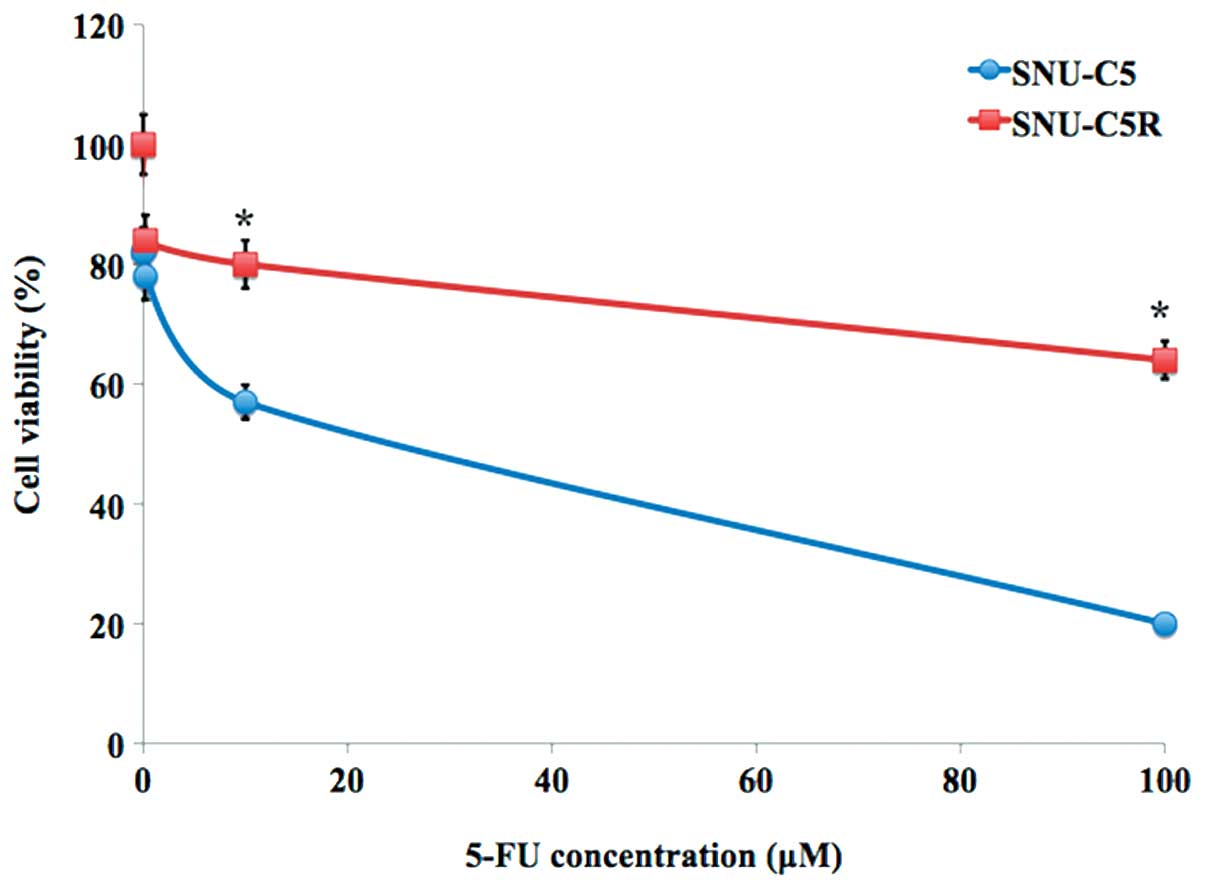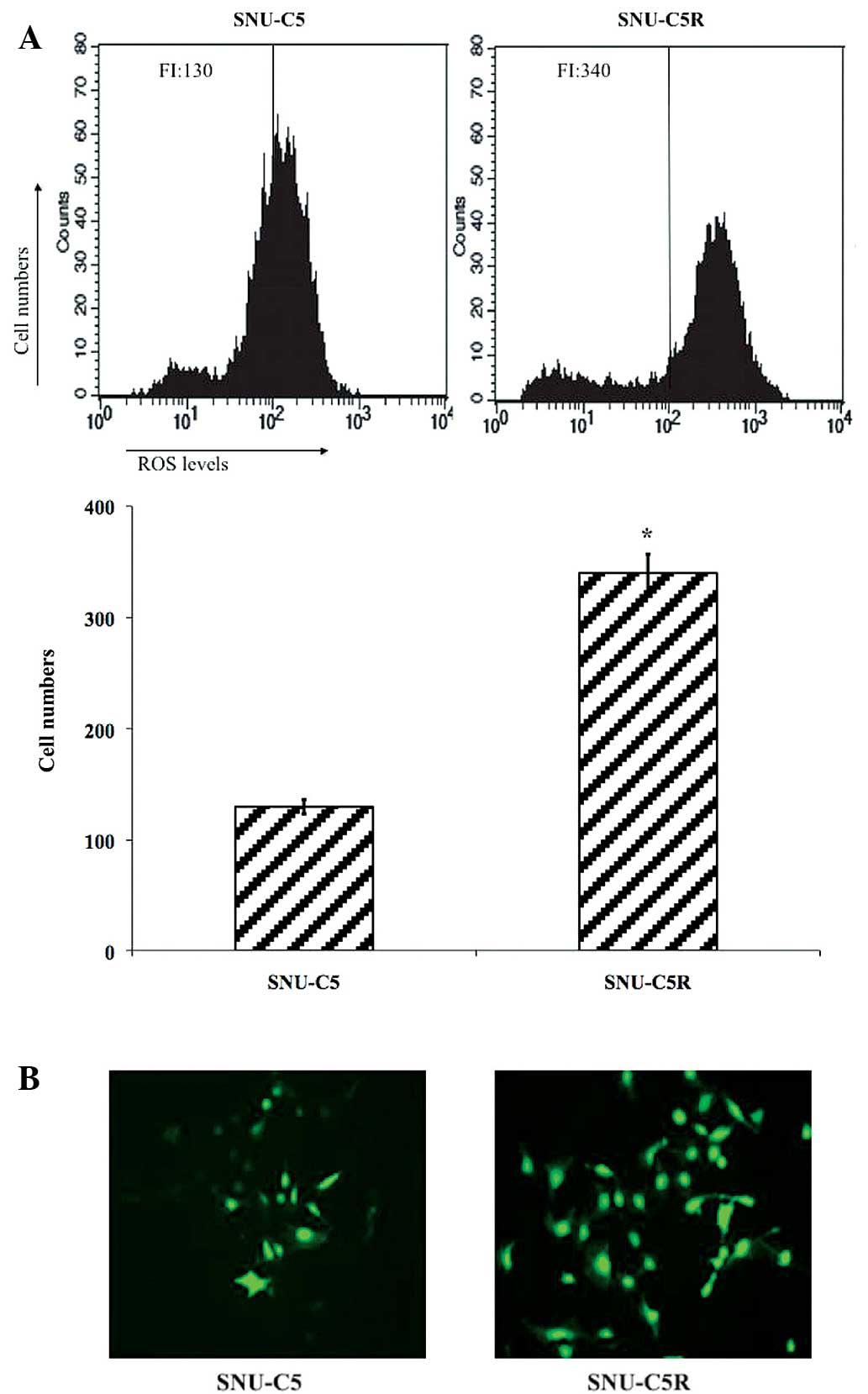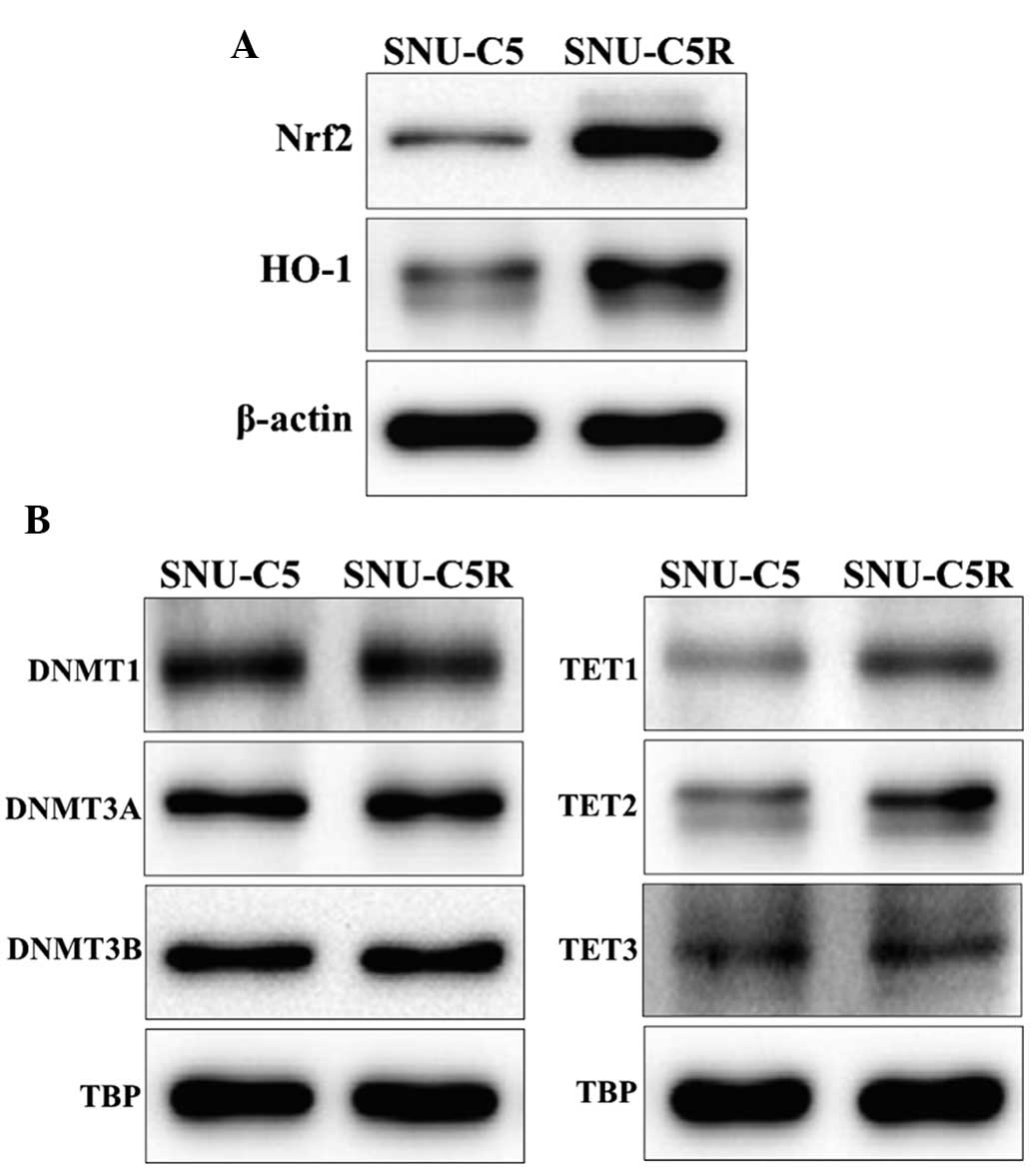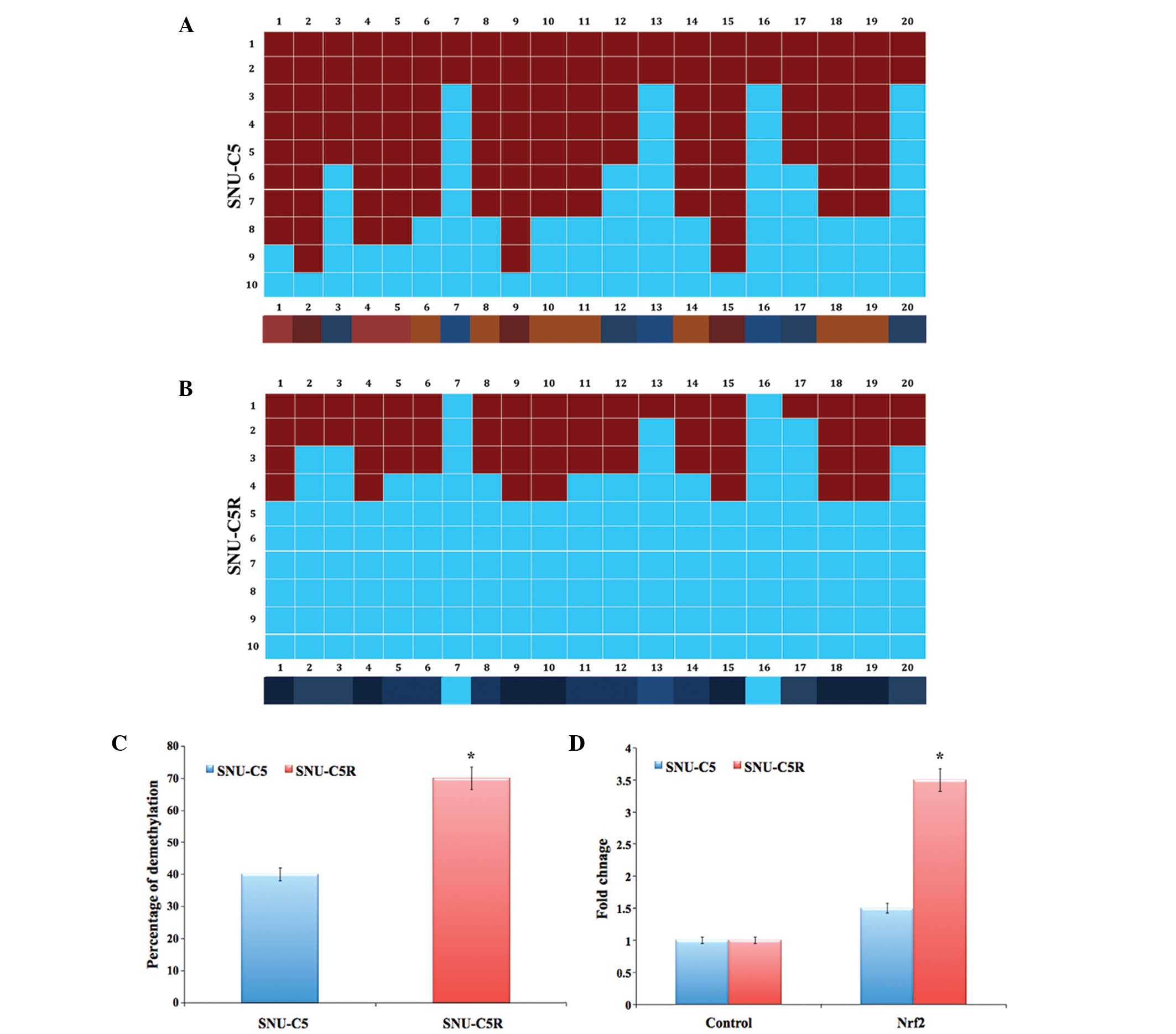|
1
|
Kang H, Kim C, Lee H, Kim W and Lee EK:
Post-transcriptional controls by ribonucleoprotein complexes in the
acquisition of drug resistance. Int J Mol Sci. 14:17204–17220.
2013. View Article : Google Scholar : PubMed/NCBI
|
|
2
|
Raguz S and Yagüe E: Resistance to
chemotherapy: New treatments and novel insights into an old
problem. Br J Cancer. 99:387–391. 2008. View Article : Google Scholar : PubMed/NCBI
|
|
3
|
Tan DS, Gerlinger M, Teh BT and Swanton C:
Anti-cancer drug resistance: Understanding the mechanisms through
the use of integrative genomics and functional RNA interference.
Eur J Cancer. 46:2166–2177. 2010. View Article : Google Scholar : PubMed/NCBI
|
|
4
|
Mishra PJ: The miRNA-drug resistance
connection: A new era of personalized medicine using noncoding RNA
begins. Pharmacogenomics. 13:1321–1324. 2012. View Article : Google Scholar : PubMed/NCBI
|
|
5
|
Mishra PJ and Bertino JR: MicroRNA
polymorphisms: The future of pharmacogenomics, molecular
epidemiology and individualized medicine. Pharmacogenomics.
10:399–416. 2009. View Article : Google Scholar : PubMed/NCBI
|
|
6
|
Xu X, Chen H, Lin Y, Hu Z, Mao Y, Wu J, Xu
X, Zhu Y, Li S, Zheng X and Xie L: MicroRNA-409-3p inhibits
migration and invasion of bladder cancer cells via targeting c-Met.
Mol Cells. 36:62–68. 2013. View Article : Google Scholar : PubMed/NCBI
|
|
7
|
Zhang N, Yin Y, Xu SJ and Chen WS:
5-Fluorouracil: Mechanisms of resistance and reversal strategies.
Molecules. 13:1551–1569. 2008. View Article : Google Scholar : PubMed/NCBI
|
|
8
|
Peters GJ, Backus HH, Freemantle S, van
Triest B, Codacci-Pisanelli G, et al: Induction of thymidylate
synthase as a 5-fluorouracil resistance mechanism. Biochim Biophys
Acta. 1587:194–205. 2002. View Article : Google Scholar : PubMed/NCBI
|
|
9
|
Boyer J, Allen WL, McLean EG, Wilson PM,
McCulla A, Moore S, Longley DB, Caldas C and Johnston PG:
Pharmacogenomic identification of novel determinants of response to
chemotherapy in colon cancer. Cancer Res. 66:2765–2777. 2006.
View Article : Google Scholar : PubMed/NCBI
|
|
10
|
Karasawa H, Miura K, Fujibuchi W, Ishida
K, Kaneko N, et al: Down-regulation of cIAP2 enhances 5-FU
sensitivity through the apoptotic pathway in human colon cancer
cells. Cancer Sci. 100:903–913. 2009. View Article : Google Scholar : PubMed/NCBI
|
|
11
|
Kurokawa K, Tanahashi T, Iima T, Yamamoto
Y, Akaike Y, Nishida K, Masuda K, Kuwano Y, Murakami Y, Fukushima M
and Rokutan K: Role of miR-19b and its target mRNAs in
5-fluorouracil resistance in colon cancer cells. J Gastroenterol.
47:883–895. 2012. View Article : Google Scholar : PubMed/NCBI
|
|
12
|
Segura-Pacheco B, Perez-Cardenas E,
Taja-Chayeb L, Chavez-Blanco A, Revilla-Vazquez A,
Benitez-Bribiesca L and Duenas-González A: Global DNA
hypermethylation-associated cancer chemotherapy resistance and its
reversion with the demethylating agent hydralazine. J Transl Med.
4:322006. View Article : Google Scholar : PubMed/NCBI
|
|
13
|
Ito S, Shen L, Dai Q, Wu SC, Collins LB,
Swenberg JA, He C and Zhang Y: Tet proteins can convert
5-methylcytosine to 5-formylcytosine and 5-carboxylcytosine.
Science. 333:1300–1303. 2011. View Article : Google Scholar : PubMed/NCBI
|
|
14
|
Ito S, D'Alessio AC, Taranova OV, Hong K,
Sowers LC and Zhang Y: Role of Tet proteins in 5mc to 5hmc
conversion, ES-cell self-renewal and inner cell mass specification.
Nature. 466:1129–1133. 2010. View Article : Google Scholar : PubMed/NCBI
|
|
15
|
Singh A, Misra V, Thimmulappa RK, et al:
Dysfunctional KEAP1-NRF2 interaction in non-small-cell lung cancer.
PloS Med. 3:e4202006. View Article : Google Scholar : PubMed/NCBI
|
|
16
|
Nioi P and Nguyen T: A mutation of Keap1
found in breast cancer impairs its ability to repress Nrf2
activity. Biochem Biophys Res Commun. 362:816–821. 2007. View Article : Google Scholar : PubMed/NCBI
|
|
17
|
Hanada N, Takahata T, Zhou Q, et al:
Methylation of the KEAP1 gene promoter region in human colorectal
cancer. BMC Cancer. 12:662012. View Article : Google Scholar : PubMed/NCBI
|
|
18
|
Hayes JD and McMahon M: NRF2 and KEAP1
mutations: permanent activation of an adaptive response in cancer.
Trends Biochem Sci. 34:176–188. 2009. View Article : Google Scholar : PubMed/NCBI
|
|
19
|
Zhang DD, Lo SC, Cross JV, Templeton DJ
and Hannink M: Keap1 is a redox regulated substrate adaptor protein
for a Cul3-dependent ubiquitin ligase complex. Mol Cell Biol.
24:10941–10953. 2004. View Article : Google Scholar : PubMed/NCBI
|
|
20
|
Cullinan SB, Gordan JD, Jin J, Harper JW
and Diehl JA: The Keap1-BTB protein is an adaptor that bridges Nrf2
to a Cul3-based E3 ligase: oxidative stress sensing by a Cul3-Keap1
ligase. Mol Cell Biol. 24:8477–8486. 2004. View Article : Google Scholar : PubMed/NCBI
|
|
21
|
Dinkova-Kostova AT, Holtzclaw WD, Cole RN,
et al: Direct evidence that sulfhydryl groups of Keap1 are the
sensors regulating induction of phase 2 enzymes that protect
against carcinogens and oxidants. Proc Natl Acad Sci USA.
99:11908–11913. 2002. View Article : Google Scholar : PubMed/NCBI
|
|
22
|
Wakabayashi N, Dinkova-Kostova AT,
Holtzclaw WD, et al: Protection against electrophile and oxidant
stress by induction of the phase 2 response: fate of cysteines of
the Keap1 sensor modified by inducers. Proc Natl Acad Sci USA.
101:2040–2045. 2004. View Article : Google Scholar : PubMed/NCBI
|
|
23
|
Thimmulappa RK, Mai KH, Srisuma S, Kensler
TW, Yamamoto M and Biswal S: Identification of Nrf2-regulated genes
induced by the chemopreventive agent sulforaphane by
oligonucleotide microarray. Cancer Res. 62:5196–5203.
2002.PubMed/NCBI
|
|
24
|
Li CQ, Kim MY, Godoy LC, Thiantanawat A,
Trudel LJ and Wogan GN: Nitric oxide activation of Keap1/Nrf2
signaling in human colon carcinoma cells. Proc Natl Acad Sci USA.
106:14547–14551. 2009. View Article : Google Scholar : PubMed/NCBI
|
|
25
|
Arlt A, Bauer I, Schafmayer C, et al:
Increased proteasome subunit protein expression and proteasome
activity in colon cancer relate to an enhanced activation of
nuclear factor E2-related factor 2 (Nrf2). Oncogene. 28:3983–3996.
2009. View Article : Google Scholar : PubMed/NCBI
|
|
26
|
Jung GR, Kim KJ, Choi CH, Lee TB, Han SI,
Han HK and Lim SC: Effect of betulinic acid on anticancer
drug-resistant colon cancer cells. Basic Clin Pharmacol Toxicol.
101:277–285. 2007. View Article : Google Scholar : PubMed/NCBI
|
|
27
|
Bourhy P, Bremont S, Zinini F, Giry C and
Picardeau M: Comparison of real-time PCR assays for detection of
pathogenic Leptospira spp. in blood and identification of
variations in target sequences. J Clin Microbiol. 49:2154–2160.
2011. View Article : Google Scholar : PubMed/NCBI
|
|
28
|
Dagert M and Ehrlich SD: Prolonged
incubation in calcium chloride improves the competence of
Escherichia coli cells. Gene. 6:23–28. 1979. View Article : Google Scholar : PubMed/NCBI
|
|
29
|
Liu GF: Median effective dose. Medical
Statistics. Jiang ZJ: 1st. People's Medical Publishing House;
Beijing: pp. 136–153. 1997
|
|
30
|
Was H, Dulak J and Jozkowicz A: Heme
oxygenase-1 in tumor biology and therapy. Curr Drug Targets.
11:1551–1570. 2010. View Article : Google Scholar : PubMed/NCBI
|
|
31
|
Becker JC, Fukui H, Imai Y, Sekikawa A,
Kimura T, Yamagishi H, Yoshitake N, Pohle T, Domschke W and
Fujimori T: Colonic expression of heme oxygenase-1 is associated
with a better long-term survival in patients with colorectal
cancer. Scand J Gastroenterol. 42:852–858. 2007. View Article : Google Scholar : PubMed/NCBI
|
|
32
|
Arnold CN, Goel A and Boland CR: Role of
hMLH1 promoter hypermethylation in drug resistance to
5-fluorouracil in colorectal cancer cell lines. Int J Cancer.
106:66–73. 2003. View Article : Google Scholar : PubMed/NCBI
|
|
33
|
Feinberg AP, Ohlsson R and Henikoff S: The
epigenetic progenitor origin of human cancer. Nat Rev Genet.
7:21–33. 2006. View
Article : Google Scholar : PubMed/NCBI
|
|
34
|
Dworkin AM, Huang TH and Toland AE:
Epigenetic alterations in the breast: Implications for breast
cancer detection, prognosis and treatment. Semin Cancer Biol.
19:165–171. 2009. View Article : Google Scholar : PubMed/NCBI
|
|
35
|
Balch C, Huang TH, Brown R and Nephew KP:
The epigenetics of ovarian cancer drug resistance and
resensitization. Am J Obstet Gynecol. 191:1552–1572. 2004.
View Article : Google Scholar : PubMed/NCBI
|
|
36
|
Akhdar H, Loyer P, Rauch C, Corlu A,
Guillouzo A and Morel F: Involvement of Nrf2 activation in
resistance to 5-fluorouracil in human colon cancer HT-29 cells. Eur
J Cancer. 45:2219–2227. 2009. View Article : Google Scholar : PubMed/NCBI
|
|
37
|
Ziech D, Franco R, Pappa A and
Panayiotidis MI: Reactive oxygen species (ROS) - induced genetic
and epigenetic alterations in human carcinogenesis. Mutat Res.
711:167–173. 2011. View Article : Google Scholar : PubMed/NCBI
|
|
38
|
Donkena KV, Young CY and Tindall DJ:
Oxidative stress and DNA methylation in prostate cancer. Obstet
Gynecol Int. 2010:3020512010. View Article : Google Scholar : PubMed/NCBI
|
|
39
|
Dawlaty MM, Ganz K, Powell BE, Hu YC,
Markoulaki S, et al: Tet1 is dispensable for maintaining
pluripotency and its loss is compatible with embryonic and
postnatal development. Cell Stem Cell. 9:166–175. 2011. View Article : Google Scholar : PubMed/NCBI
|
|
40
|
Rudenko A, Dawlaty MM, Seo J, Cheng AW, et
al: Tet1 is critical for neuronal activity-regulated gene
expression and memory extinction. Neuron. 79:1109–1122. 2013.
View Article : Google Scholar : PubMed/NCBI
|













